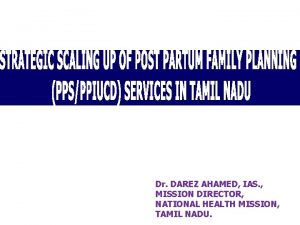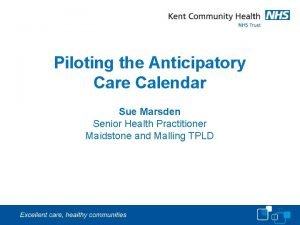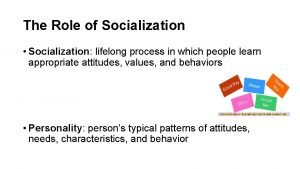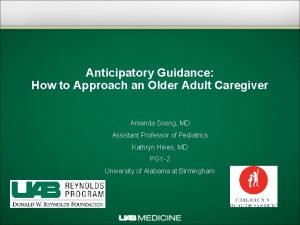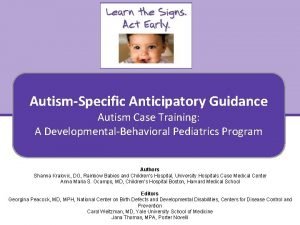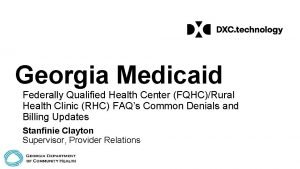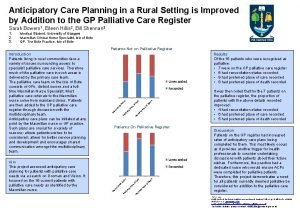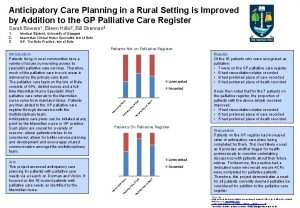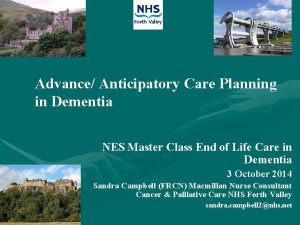ANTICIPATORY CARE Dr RIYAZ AHAMED DEPARTMENT OF COMMUNITY




















- Slides: 20

ANTICIPATORY CARE Dr RIYAZ AHAMED DEPARTMENT OF COMMUNITY MEDICINE

At the end of the teaching session, the student should be able to: � Define anticipatory care � List the different levels of anticipatory care � Apply the different levels of anticipatory care to real life situations � Discuss the criteria for screening of disease (including Wilson’s criteria) � Design a basic plan for a screening program for a common health problem.

Definition of Anticipatory Care �A plan that anticipates significant changes in a patient ( or their care needs) and describes action, which could be taken, to manage the anticipated problem in the best way. �It is used by healthcare professionals to record decisions agreed with patients about their anticipated care needs and wishes. �These discussions should include family/ carers / representatives whenever possible.

All measures aimed to promote good health & prevent or delay disease or their complications In other words: Prevent the need for future intervention This care aims to: Improve the quality of life Reduce the premature disability Increased life expectancy

The concept of risk is important to an anticipatory approach, and relates to the probability of an event or situation which is detrimental to health. � Risk factors can be: Ø Those relating to 'life circumstances' (socio-economic factors – e. g. poverty or poor housing, the physical environment), Ø Health-related behaviors ('lifestyle' factors like smoking, alcohol, diet, physical activity). Ø Clinical risk factors (such as high blood pressure, obesity, high cholesterol and impaired glucose metabolism) Ø Diseases (heart disease, stroke, cancer, mental illness etc. )


PHASES OF ANTICIPATORY CARE PLANNING Levels of care Details Phase 1 Self management phase - where patients, family and carers can be given the information/knowledge and support to adapt their life style in order that they can stay as well as possible. Phase 2 Personal management planning - through prompt action patients can prevent the development of exacerbation to the stage where hospital admission is required. Phase 3 Anticipatory Care Plans - what further support a patient would require from family and informal carers to stay as well as possible and what short term step up of health or care social care can be provided to prevent an avoidable admission. Phase 4 End of life phase - Ensuring the patient remains as well as possible for as long as possible. Phase 5 Next phase of ACP - The challenge of helping family and friends who have cared for people through to the palliative and end of life phases to re-engage with their community.

Potential benefits of Anticipatory Care Planning �Patients receive the care they desire �Appropriate management �Support for decision making �Reducing the risk of complicated grief

Applying the different levels of anticipatory care Contact number of relatives & carers Patient carers GP appointments Appropriate hospital admissions

Examples of Anticipatory Care

HEALTH PROMOTION AND DISEASE PREVENTION Health promotion 1. Health education 2. Environmental modification Disease prevention

PREVENTION � 1. 2. 3. 3 levels of prevention Primary prevention Secondary prevention Tertiary prevention

PREVENTION �Primordial prevention: Defined as Prevention of emergence or development of risk factors in countries/population groups in which they have not yet appeared. Eg: In case of OBESITY in tribal population – discouraging the adoption of harmful behaviour and impress upon good life style.

PRIMARY PREVENTION �Action taken prior to the onset of disease, which removes the possibility that the disease will ever occur. �Primary prevention is used prominently in the field of noncommunicable diseases where there is no specific agent responsible for causation of disease. In such cases we use term Risk factor.

PRIMARY PREVENTION HEALTH PROMOTION: The process of enabling people to increase control over, and improve health. It INCLUDES � Health education, � environmental modification, � lifestyle and behavioural modification a � nutritional intervention. 2. SPECIFIC PROTECTION Protecting the individual or population against given disease by taking specific measures. Eg: 1. Immunization 2. Protection against accidents 3. Protection against occupational diseases. 1.

SECONDARY PREVENTION �Early diagnosis and treatment: Detecting the diseases in early stage by using tests and providing proper treatment. Eg: Diagnosis of AIDS and providing ART. �It prevent the spread of the disease in the community. TERTIARY PREVENTION Defined as All measures available to reduce or limit impairment and disabilities, minimize suffering caused by existing departure from good health. � 2 modes of Intervention: 1. Disability limitation 2. Rehabilitation �


SCREENING: testing for infection or disease in populations or individuals who are not seeking health care e. g: neonatal screening, HIV testing in blood donors CASE FINDING: testing to identify disease in individuals seeking health care for other reasons. e. g. , VDRL in pregnant womento detect syphilis DIAGNOSTIC TEST: use of clinical and/or laboratory procedures to confirm or refute the existence of disease endocervical culture for N. gonorrhea ref: park text book of PSM 21 st edition page no. 125

Why disease screening is very important

 Riyaz faizullabhoy
Riyaz faizullabhoy Darez ahamed education
Darez ahamed education Anticipatory care calendar
Anticipatory care calendar Anticipatory care definition
Anticipatory care definition Primary secondary tertiary care
Primary secondary tertiary care Socialization process
Socialization process Anticipatory set meaning
Anticipatory set meaning Example of anticipatory socialization
Example of anticipatory socialization George herbert mead i'' and me
George herbert mead i'' and me Anticipatory socialization
Anticipatory socialization Anticipatory set
Anticipatory set Anticipatory guidance for elderly
Anticipatory guidance for elderly Socialization def
Socialization def Anticipatory guidance for autism
Anticipatory guidance for autism Anticipatory set ideas
Anticipatory set ideas Anticipatory innovation governance
Anticipatory innovation governance Leaflet anticipatory guidance
Leaflet anticipatory guidance What is anticipatory bail
What is anticipatory bail Define anticipatory set
Define anticipatory set New york city department of youth and community development
New york city department of youth and community development Georgia department of community health
Georgia department of community health

